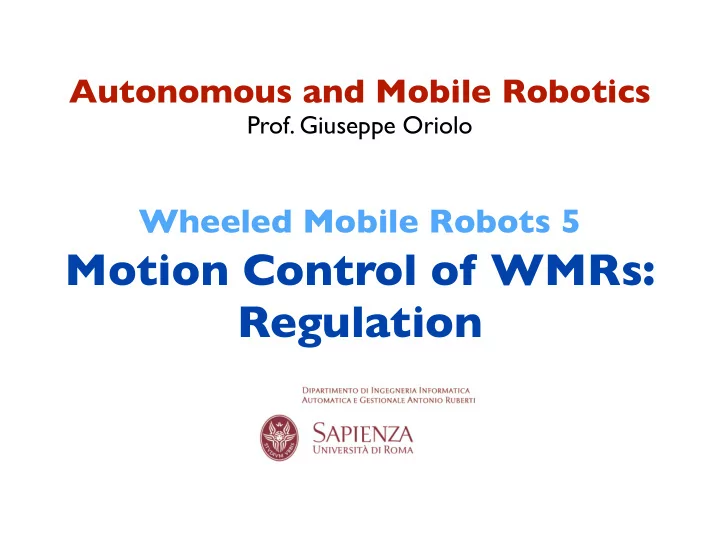

Autonomous and Mobile Robotics Prof. Giuseppe Oriolo Wheeled Mobile Robots 5 Motion Control of WMRs: Regulation
regulation • drive the unicycle to a desired configuration q d • the obvious approach (choose a path/trajectory that stops in q d , then track it via feedback) does not work: - linear/nonlinear controllers based on the error dynamics require persistent trajectories - i/o linearization leads point B to the destination rather than the representative point of the unicycle • being nonholonomic, WMRs (unlike manipulators) do not admit universal controllers, i.e., controllers that can stabilize arbitrary trajectories, persistent or not Oriolo: Autonomous and Mobile Robotics - Motion Control of WMRs: Regulation 2
cartesian regulation • drive the unicycle to a given cartesian position (w.l.o.g., the origin (0 0) T ) with any orientation • consider the control law • v is proportional to the projection of e p = (— x , — y ) on the sagittal axis • ! is proportional to the pointing error (the difference between the orientation of the unicycle and that of e p ) Oriolo: Autonomous and Mobile Robotics - Motion Control of WMRs: Regulation 3
• Lyapunov-like function positive semidefinite negative semidefinite • cannot use La Salle theorem, but Barbalat lemma implies that tends to zero, i.e. • under the proposed controller, this implies that the cartesian error goes to zero Oriolo: Autonomous and Mobile Robotics - Motion Control of WMRs: Regulation 4
��� ��� � � � �� �� � � � �� �� ��� � � � �� �� � � � �� �� ��� simulation • final orientation is not controlled • at most one backup maneuver Oriolo: Autonomous and Mobile Robotics - Motion Control of WMRs: Regulation 5
� � � � � � � posture regulation • drive the unicycle to a given configuration (w.l.o.g., the origin (0 0 0) T ) • convert to polar coordinates Oriolo: Autonomous and Mobile Robotics - Motion Control of WMRs: Regulation 6
• kinematic model in polar coordinates note the singularity at the origin • consider the control law (compare with previous) Oriolo: Autonomous and Mobile Robotics - Motion Control of WMRs: Regulation 7
• Lyapunov candidate positive definite negative semidefinite • Barbalat lemma implies that ½ , ° and ± go to zero • the above control law, once mapped back to the original coordinates, is discontinuous at the origin • in fact, due to the nonholonomy, all posture stabilizers must be necessarily discontinuous w.r.t. the state or time-varying Oriolo: Autonomous and Mobile Robotics - Motion Control of WMRs: Regulation 8
��� ��� ��� � � � �� �� � � � �� �� ��� � � � �� �� � � � �� �� simulation • final orientation is zeroed as well • at most one backup maneuver Oriolo: Autonomous and Mobile Robotics - Motion Control of WMRs: Regulation 9
Recommend
More recommend